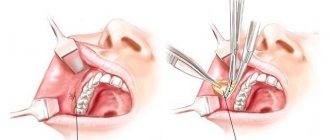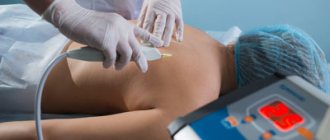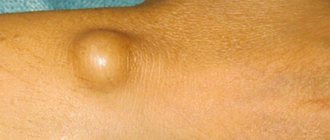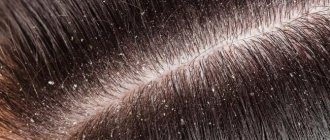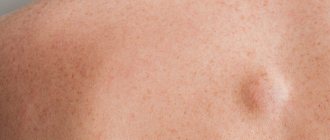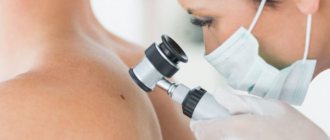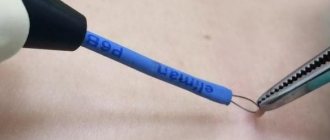Atheroma is a benign tumor that appears in most cases on areas of the skin with thick hair.
The nature of this neoplasm is clear to medicine - for certain reasons, the sebaceous gland becomes blocked, as a result of which an inflammatory process begins inside it.
Initially, atheroma may be almost invisible and not cause pain. At the first stage of development, the neoplasm can be detected by palpation of this area of the body - it seems that under the skin there is a fairly strong capsule with liquid inside.
When the inflammatory process inside the sebaceous gland is activated, the tumor begins to grow rapidly. In some cases it can reach the volume of a chicken egg. The person does not experience any painful sensations.
Why is it necessary to treat atheromas?
Content:
- Why is it necessary to treat atheromas?
- Preparation for the procedure
- Advantages of laser technique
- Features of the procedure
- Recovery period
Sometimes such a cyst can “exist” for several years, not grow and not affect the quality of life. But at any moment an inflammatory process can begin, provoking the formation of a large amount of pus. If atheroma breaks out spontaneously, it is possible that the affected tissue areas become infected and the infection enters the blood. An ulcer forms at the site of the breakthrough, which does not heal well.
When pus begins to accumulate inside the clogged sebaceous gland, the process is accompanied by the appearance of a specific putrefactive odor, which becomes noticeable not only to the patient himself, but also to those around him. This phenomenon cannot but affect the quality and comfort of life. But the biggest risk of atheroma is that a benign tumor can transform into a malignant tumor over time.
It is strictly forbidden to try to remove a subcutaneous cyst on your own - such manipulations very often cause negative consequences. When contacting a specialist, the removal procedure takes little time, is affordable and is characterized by an almost complete absence of pain.
How much does laser cyst removal cost?
For laser cyst removal, the price is primarily determined by the type and size of the cyst. So, to remove an atheroma costs up to 7,000 rubles, a soft tissue cyst costs just over 9,000 rubles. The surgeon examines the cyst and can then tell you how much it will cost to remove the cyst in a particular case.
If the surgeon has free time and the patient has the opportunity to undergo preparatory examinations, laser cyst removal (meaning soft tissue cysts that are localized under or inside the skin) can be performed on the day of treatment.
Preparation for the procedure
After the patient has been diagnosed with atheroma, he is indicated for surgery to remove it. Preliminary preparation for the procedure includes passing the necessary list of general tests and ultrasound examination of the area in which the cyst is located. This will allow the specialist to see the full picture and determine how difficult the upcoming operation will be. The main purpose of laser exposure to an encapsulated sebaceous gland is to completely remove the fluid inside and destroy the cyst shell. In the case when even a small fragment of the shell remains inside, there is a high probability of relapse of the disease.
3 days before the date of surgery, the patient is advised to completely stop drinking alcohol and smoking. Additionally, there are restrictions on taking certain medications—blood thinning medications are prohibited. If it is impossible to completely refuse drugs from this group, the patient must notify the specialist who will perform laser removal of the atheroma.
Rehabilitation period after removal of atheroma
The duration of the rehabilitation period depends on the method of removing atheroma and the area of intervention. With laser removal of small tumors, tissue is restored within a week. A scab forms at the site of laser treatment. The duration of complete recovery after surgical removal of atheroma depends on the size of the formation and averages 1 to 2 weeks. During this period, the seam should be regularly treated in accordance with the doctor’s recommendations.
Until complete recovery, the area of skin where the atheroma was removed should not be scratched/damaged in any other mechanical way; sun exposure to this area must be avoided. In addition, you should avoid visiting the solarium, swimming pool, sauna and bathhouse.
Advantages of laser technique
Removing atheroma using a laser beam has significant advantages over the standard surgical method. In particular:
- high effectiveness of therapy, justified by the direct effect of ultraviolet radiation on the site of inflammation;
- short recovery period - healing is noted already 10-15 days after the procedure;
- significant reduction in the risk of re-clogging the sebaceous gland;
- simple preparatory period;
- after removing atheroma with a laser, there are no scars or scars left on the skin.
The procedure for laser excision of a subcutaneous cyst is performed under local anesthesia. If the patient turns to a specialist for help in a timely manner, the operation is carried out as planned and is not accompanied by pain or discomfort.
Indications for removal of atheroma
Most often, atheroma does not cause physical discomfort; in such cases, the indication for removal of the formation is the patient’s aesthetic desire to get rid of the defect. There are a number of medical indications for removing atheroma:
- pain and redness at the location of the tumor;
- increased body temperature;
- bloody discharge from the neoplasm;
- a sharp increase in tumor size;
- abscess;
- education breakthrough.
Features of the procedure
The duration of the operation is from 60 to 90 minutes, depending on the complexity of the particular case. First, an antiseptic treatment of the required area of skin is carried out and drugs for local anesthesia are administered.
The specialist, directing the laser beam to the area of skin located directly above the atheroma, dissects the skin.
Next comes the stage of evaporating the accumulated liquid. Then the beam destroys the remains of the capsule and seals the vessels. If a large tumor is to be removed, a cosmetic suture is placed at the site of the skin incision.
In most cases, this manipulation is not necessary - after 5-10 days, the hole formed at the site of the atheroma becomes invisible.
In the case when an active inflammatory process has begun inside the cyst and it has increased to its maximum volume, a combination of surgical and laser techniques is recommended. In this case, general anesthesia is used.
The skin is cut with a laser, and the capsule with liquid itself is removed mechanically. Then laser treatment of the resulting cavity follows again in order to seal the vessels and burn out the remaining tumor. In this case, the postoperative recovery period increases to 3 weeks.
Operation stages
To carry out this technique for removing atheroma, local anesthesia is used. Duration of the procedure is 1 hour. The operation goes through several stages.
- First, the patient is treated with antiseptics and painkillers are administered.
- The skin is then cut with a laser beam.
- The capsule and contents are evaporated.
- The cavity is processed and the vessels are sealed. If necessary, stitches may be required.
If the atheroma has reached a large size, a complex removal method is used, which includes laser and surgery. In this case, the steps will be as follows.
- The skin is treated with antiseptics.
- Anesthesia is administered.
- The skin is cut using a laser.
- The capsule is removed mechanically.
- The cavity is treated and sutures are applied.
After the operation, a hole is formed. It lasts for 21 days.
Laser removal is a minimally invasive and safe procedure. However, an experienced surgeon will not forget to check with the patient about possible contraindications. This could be diabetes, cancer, a tan that a person received 10 days before the procedure, or pregnancy.
After undergoing such a procedure, many patients note that they did not experience any pain or discomfort. There were no complications and no side effects. The manipulations were carried out without contact. And complete healing occurred before the time specified by the doctor.
Diagnostic methods in surgery:
- Doppler in surgery
- Colonoscopy
- Angiography
- CT scan
- Gastroscopy
- MRI
- Abdominal ultrasound
- X-ray
- Endoscopy
Prices:
| Code | Name of service | Prices |
| 1 | Initial appointment | 1200 |
| 2 | Repeated appointment | 900 |
| 3 | Calling a surgeon to your home | 3500 |
| 4 | Abdominal ultrasound | 2200 |
| 5 | Ultrasound of veins and vessels | 2400 |
| 6 | Doppler 2-3 trimester | 1200 |
| 7 | Rectoscopy | 1500 |
Infectious “cosmetic defects”.
- Papillomas
Caused by the human papillomavirus. If there are a lot of them, it means that local skin immunity is reduced. They look like small “bags” the color of healthy skin. They are located on a thin stalk or sit in a rounded “button”. They are located on the skin of the neck, armpits and under the breasts, but can be found almost anywhere. Almost all people have them in one quantity or another.
Papillomas are formations of the most superficial layer of the skin, so the skin heals well and quickly after their removal.
- Warts
An infectious process caused by the human papillomavirus. The formations are often round in shape with a rough, rough surface. They can be quite large. They can be found anywhere, although more often on the skin of the hands and feet. You need to pay special attention to the appearance of warts near the nail or on the sole of the foot, since their removal is difficult and it is better to remove them while they are small.
It is necessary to remove it by electrocoagulation, laser, or liquid nitrogen.
In case of multiple warts, an examination is needed to identify possible causes that contribute to a decrease in immunity, and comprehensive treatment.
- "Calls"
A type of “infectious” callus located on the sole or between the toes. Most often they form against the background of orthopedic foot defects, venous insufficiency, excessive sweating, and regular wearing of uncomfortable shoes. Because of such problems, against the background of a decrease in the local immunity of the foot, microorganisms can form painful, inflamed thickenings of the skin - “corns”. They usually try to fight them with frequent pedicures, but this does not help.
Treatment of “corns” is not a quick, complex process, but very useful, since a painful “corns” that interferes with walking forces people to finally begin treating diseases and processes that contribute to its appearance.
In any case, you need to start with a consultation with a qualified dermatologist-cosmetologist.
DRUGS AND DEVICES
Laser resurfacing of enlarged pores is usually carried out using specialized devices:
- MultiPulse CO2;
- Dermablate;
- Fraxel;
- Sciton Halo.
Also in the clinic you can undergo RF needle lifting using Infini, and take a course of chemical peels. Perhaps, based on the results of the initial consultation, the cosmetologist will recommend you another method of treating enlarged pores - the clinic uses all available possibilities for this. Specialists provide assistance in choosing cosmetics and allow you to purchase special care products directly from us. Their use will improve the results of treating enlarged pores and increase the effectiveness of hardware and other procedures.
Mesotherapy and biorevitalization are also used, but hardware techniques are in great demand in solving the problem of enlarged pores. Procedures can be carried out one-time (one time, with a certain frequency) or courses. Different methods give different effects; the choice of one direction or another will determine the duration and complexity of rehabilitation.
How can I reduce the risk of complications after a surgical procedure?
After the operation, the surgeon at the Konstanta Clinic consults the patient and tells in detail how to behave at home and care for the skin. Most often, complications arise when trying to self-medicate, using aggressive traditional methods, which lead to chemical burns and increase the risk of secondary infection. It is important to follow all medical recommendations, change aseptic dressings on time and not miss preventive appointments with a specialist.
Treatment of atheromas should be carried out by an experienced specialist who often encounters such neoplasms and knows how to treat them with maximum efficiency and safety for the patient’s health.
What are the features of the surgical approach?
If the formation is too large, a consultation with a surgeon may recommend removal under local anesthesia. The cyst is excised along with the capsule to prevent relapses. There are three surgical options for uncomplicated cases:
- The skin is cut under the area where the atheroma protrudes the most. The contents are squeezed out and collected with a napkin. The capsule is removed using a clamp or the cyst cavity is scraped out with a special sharp spoon from the surgeon’s arsenal.
- The skin is cut so as not to damage the capsule, then the skin is moved, the doctor presses the edges of the wound with his fingers and peels out the rest.
- Two bordering incisions are made above the cyst, which cover its opening. The edges are grasped with surgical clamps and lifted, and the jaws of curved scissors are placed under the atheroma, with the help of which the formation is peeled out of the tissue. Sutures of absorbable threads are placed on the subcutaneous tissue, and vertical mattress sutures are placed on the skin with a thin traumatic thread, which is removed after a week.
In case of suppuration, any intervention is contraindicated. Only opening is practiced to ensure external drainage of purulent contents.
